How to determine the spray drying parameters of dairy and food concentrates?
- Like
- Digg
- Del
- Tumblr
- VKontakte
- Buffer
- Love This
- Odnoklassniki
- Meneame
- Blogger
- Amazon
- Yahoo Mail
- Gmail
- AOL
- Newsvine
- HackerNews
- Evernote
- MySpace
- Mail.ru
- Viadeo
- Line
- Comments
- Yummly
- SMS
- Viber
- Telegram
- Subscribe
- Skype
- Facebook Messenger
- Kakao
- LiveJournal
- Yammer
- Edgar
- Fintel
- Mix
- Instapaper
- Copy Link
Posted: 12 December 2009 | Pierre Schuck & Romain Jeantet, INRA and Agrocampus Ouest and Eric Blanchard, Laiterie de Montaigu | No comments yet
The second and concluding instalment of Pierre Schuck and associates’ article on spray drying parameters of dairy products discusses the results and conclusions of their research. The most frequently used technique for dehydration of dairy and food products is spray drying. This is an effective method for preserving biological products as it does not involve severe heat treatment and it allows storage of powders at an ambient temperature.
The second and concluding instalment of Pierre Schuck and associates' article on spray drying parameters of dairy products discusses the results and conclusions of their research. The most frequently used technique for dehydration of dairy and food products is spray drying. This is an effective method for preserving biological products as it does not involve severe heat treatment and it allows storage of powders at an ambient temperature.
The second and concluding instalment of Pierre Schuck and associates’ article on spray drying parameters of dairy products discusses the results and conclusions of their research. The most frequently used technique for dehydration of dairy and food products is spray drying. This is an effective method for preserving biological products as it does not involve severe heat treatment and it allows storage of powders at an ambient temperature.
Due to the variety and complexity of the concentrates to be dried, a more rigorous understanding of spray-drying based on physico-chemical and thermodynamic properties has now become necessary. However, the current knowledge does not allow determination of the parameters of spray-drying of dairy products. The only way to determine these parameters is to perform several complex and expensive experiments with spray-dryer pilots.
Results and discussion
Drying by desorption
The main aim of this study was to develop a method to simulate the transfer conditions (energy and water) of spray-drying. Typical curves (shown in Figure 2) were registered with the water activity meter, on pure water at two different sample weights (80 milligrams for water N°1 and 160 mg for water N°2) and on skim milk concentrates at different TS contents. These curves showed that the relative humidity (RH) from the pressure sensor as a function of time and as a function of skim milk concentrates and water can be represented by a sigmoid equation17:
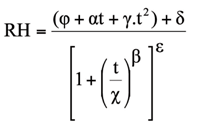

(1)
where
t = Time of drying
.ϕ. α .γ = Coefficients of the equation of the first part of the curves
δ = Final value for RH
χ = Inflection point
β = Slope of the sigmoidal part of the inflection point
ε = Asymmetry coefficient
Two phases can be identified on the curves obtained for pure water and milk concentrates:
Initially, at the beginning of desorption, there was a constant RH (ie rate of drying) phase, which remained at approximately 30 per cent whatever the product. This constant phase corresponds to free water evaporation. The second phase was the falling rate period, which was very short for pure water and much longer for milk concentrates, whatever the total solid content. We assumed that this corresponded to the evaporation of bound water, which involves extra energy (ΔE) in order to overcome binding (indirectly the bound strength of water). The area under the curve of each part thus represents the amounts of free and bound water desorbed, respectively. ΔE is calculated as a function of the drying kinetics according to the desorption curves (Figure 2). When the drying kinetic of a concentrate is similar to the drying kinetic of pure water, no DE is required. If the drying kinetic is two slower, energy requirement is two higher than for pure water. The difference with the latent heat of evaporation required for pure water determines ΔE.
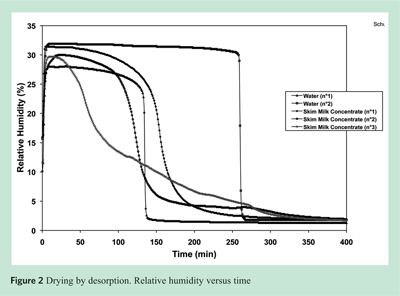

The TS contents determined after oven drying and after drying by desorption are shown in Table I. The values were very close compared to the theoretical findings although the standard deviations for drying by desorption were higher. The both before last columns of this Table show that the area under each curve for pure water and skim milk concentrates was related to the water content. The determination coefficient was close to 0.99. This correlation showed that drying by desorption can remove almost all the water whatever its nature (bound or free). The pure water sample (N°1) and the skim milk concentrate (N°3) had the same water content (80 mg) and similar areas under the curve (3579 per cent min and 3712 per cent min, respectively), but not the same drying time (approximately 150 min for pure water compared to 350 min for skim milk concentrate – see Figure 2) and not the same extra energy (ΔE) compared to total energy (Table I). The difference may be related to the change of diffusivity or availability of the water: the more bound the water, the longer the drying time. In first time, extra energy (ΔE) must be found to release the bound water physically and chemically, and then in second time, this released water could be evaporated by using the latent heat of evaporation, like pure water.
Drying parameters
To introduce our modelling approach, the known and unknown air parameters in a spray dryer are represented in Figure 3. Three points are very important in characterisation in terms of temperature (T, °C), relative humidity (RH, per cent) and absolute humidity (AH, kg water.kg-1 Dry Air [DA]). Points 0, 1 and 2 correspond to the inlet air before heating, after heating (increasing in T) and after drying (increase in AH), respectively. Air 0 characteristics can be easily determined by using a thermo-hygrometer. The AH of point 2 (AH2) is given by dryer capacity, based on free water evaporation, and the RH of point 2 (RH2) is given by the thermodynamic equilibrium between powder and outlet air10,21. This is mainly dependent on dryer configuration: for example, the RH2 corresponding to 0.2 aw powder production is 10, 15 and 20 per cent in single, two and three stage dryers, respectively. Outlet air temperature (T2) is then obtained using the humid air chart. Finally, considering point 1, AH1 is easily obtained from AH0, considering either electric or gas (40 mg water.kg-1 air.°C-1) heating. However, T1 and RH1 are unknown, except in the case of isenthalpic drying of free water (see Figure 4), obtained in quite unrealistic conditions from an industrial point of view, by considering that spray drying is performed with no energy loss and by removing only free water. Comparing theoretical values and real values from dairy companies, Figure 4 shows a significant difference between the theoretical (points 0, 1 and 2) and real values (points 0, 1* and 2). The difference between 1 and 1* in corresponding enthalpy should be directly correlated to extra energy ΔE, which is calculated as a function of the surface area under the curve of bound water desorbed according to the desorption curves (Figure 2). Thus, the desorption method could take account of water availability.
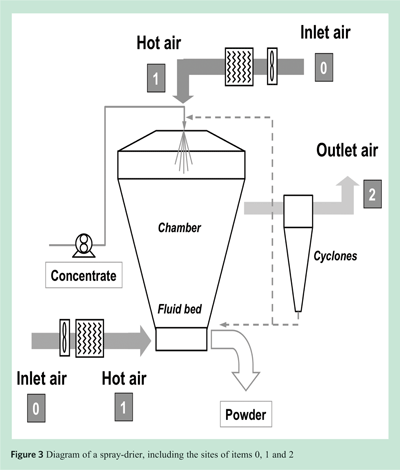

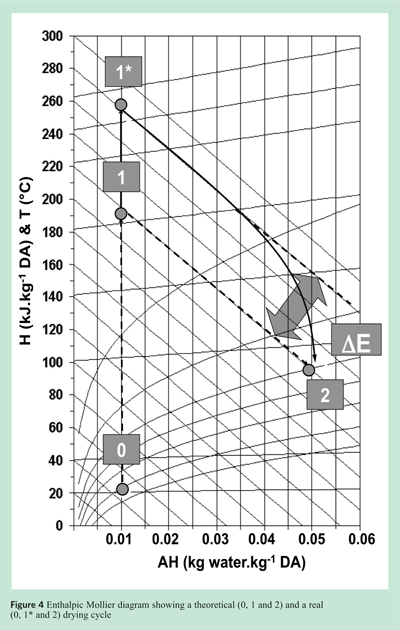

The calculation method to determine ΔE was computerised to obtain new software (SD2P®, Spray Drying Parameter Simulation & Determination) and registered at the APP (Association pour la Protection des Programmes) under the following identification IDDN.FR.001.480002.002.R.P. 2005.000.30100. The next paragraph shows the relevance of this method.
Analysis of the desorption curve (Figure 2) combined with knowledge of the temperature, total solids, density and specific heat capacity of the concentrate, air flow rates, theoretical water content in relation to water activity and RH2, the current weather conditions (point 0), cost per kWh and the percentage of drying in the integrated fluid allowed determination of enthalpy, T, RH (of point 1 including ΔE) for each air, concentrate and powder flow rate, energy specific consumption, energy and mass balance, yield of the dryer and cost (in Euros or in US dollars) to remove one kilogram of water or to produce one kilogram of powder. All these results are summarised in Figure 5. This figure is a representation of the software delivery:
- in the upper part, air characteristics at the dryer / integrated fluid bed inlet and outlet
- in the lower part, flow, energy and cost calculations
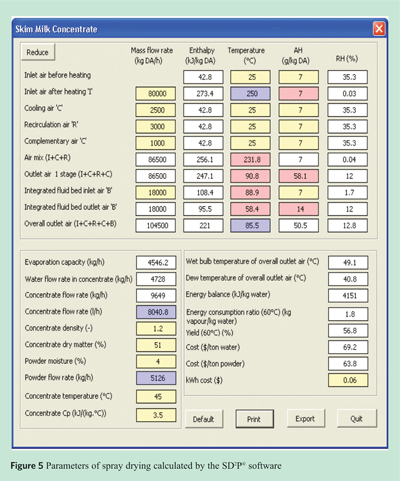

Figure 6 represents the inlet air predicted as a function of the inlet air measured during 38 experiments (on skimmed milk, glucose syrup, WPI, MCI, infant formula milk and crystallised lactose whey) and on five types of spray dryer (from 5 kg.h-1 to 6000 kg.h-1). The correlation was excellent, as were those calculated on the other parameters such as outlet air temperature, concentrate flow rate, powder flow rate and outlet air absolute humidity appearing in Table 2. The correlation is less good for the calculated inlet air temperature without integration of the DE except for pure water which has no required ΔE.
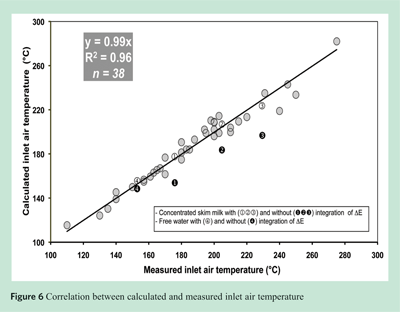

Conclusions
This study shows that drying by desorption is an excellent tool to determine the major spray-drying parameters in relation to biochemical composition according to water availability, and to their desorption behaviour (calculation of the DE). The experimental device differs from the spray-drying installation in terms of duration of drying, temperature of drying, surface / volume ratio, etc. However, for these reasons some computational tools have been developed to improve the method by taking this into account. Validation tests (> 30 products) indicated that this method could be applied to a wide range of food products and spray-dryer types. For reasons of calculation speed and reliability, this method has been computerised and it can already be used in the determination of parameters of spray drying for food products. The name of the new software is ‘Spray Drying Parameter Simulation and Determination Software’ (SD2P®) registered under the following identification: IDDN.FR.001.480002.002.R.P.2005. 000.30100.
Acknowledges
This articles uses information from the author’s original paper entitled ‘Drying by desorption: a tool to determine spray drying parameters’ in Journal of Food Engineering 94, 199-204 (2009).
References
10. Schuck, P., Méjean, S., Dolivet, A., Jeantet R., 2005. Thermohygrometric sensor: a tool for optimizing the spray drying process. Innovative Food Science and Emerging Technology 6, 45-50.
21. Schuck, P., Dolivet, A., Méjean, S., Jeantet, R., 2008. Relative humidity of outlet air: key parameter to optimize moisture content and water activity of dairy powder. Dairy Science & Technology 88, 45-52.
Issue
Related people
Eric Blanchard, Laiterie de Montaigu, Pierre Schuck, Romain Jeantet




